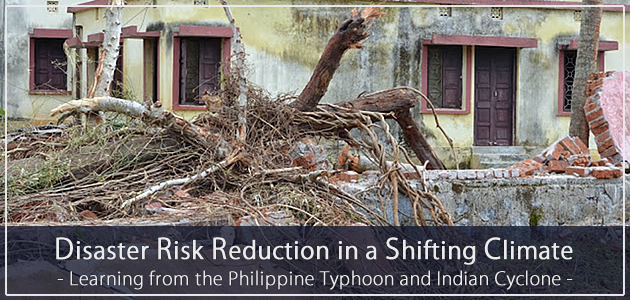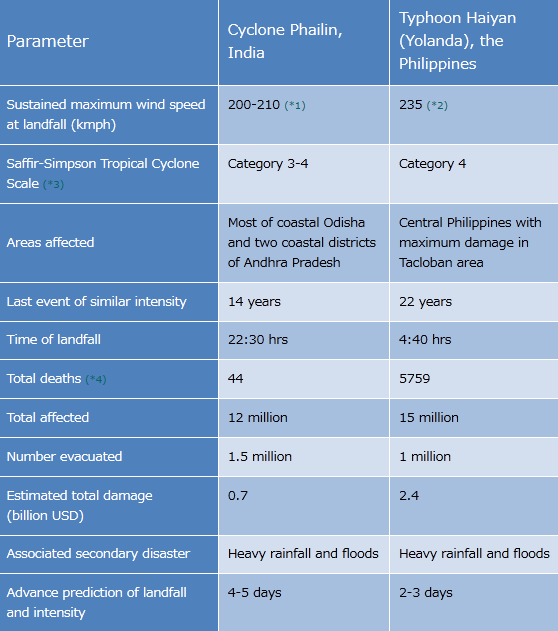
Disaster Risk Reduction in a Shifting Climate
Phailin has left behind widespread devastation in the state of Odisha, India © A. Shreekanth, CIP
The world has seen a growing number of extreme events and related impacts during the recent past. This has triggered debate on the connection between climate change and disasters and even more so renewed the interest in addressing these impacts in a more effective manner. The nineteenth session of the Conference of the Parties (COP 19) to the United Nations Framework for Climate Change Convention (UNFCCC) has just completed and the Warsaw International Mechanism (WIM) for Loss and Damage associated with climate change impacts has been established. In addition, the IPCC (Intergovernmental Panel on Climate Change) the Working Group II contribution to the Fifth Assessment Report (AR5) on "Climate Change 2014: Impacts, Adaptation, and Vulnerability", will be released in March 2014 in Yokohama, Japan. With this backdrop, we hear from Dr. Sivapuram Prabhakar, Task Manager and Senior Policy Researcher, Natural Resources and Ecosystem Services Area, IGES on “disaster risk reduction in a shifting climate”.
Lessons from Recent Extreme Events
---What can you tell from the recent typhoon in the Philippines and cyclone in India? Are there any commonalities and differences and why?
SIVAPURAM:
One of the ways of judging the efficacy of the disaster risk reduction (DRR) systems of any country is to look at how the government and other stakeholders have responded to a disaster and the subsequent impacts in terms of lives lost and property destroyed etc. However, the comparison of disasters in two countries has to be done with more caution and requires deeper analysis than what the numbers suggest on the surface since the efficacy of DRR measures could vastly differ. This is because the DRR is the primary responsibility of local governments which differ in their capacities. It also depends on the strength of the event in question and can vary depending on the time of landfall of the event (i.e. time of the day and month of the year) .
Table 1 provides a comparison of tropical cyclones Phailin that hit Odisha, India on 12 October 2013 and Haiyan that hit the Philippines’ Eastern Visayas (central Philippines) on 8 November. The following observations explain the reasons behind the severe damage from Haiyan: a) Typhoon Haiyan was unarguably the stronger typhoon and was at its peak strength when it made landfall, b) The short early warning period (the first early warning available for a stronger Haiyan was on 5 November when it was forecasted that wind speeds would reach 167 kmph, while the India Meteorological Department (IMD) was able to track cyclone Phailin 4-5 days before landfall with a forecasted wind speed of 180 kmph), c) Earlier landfall than expected, d) Slower and insufficient evacuation measures before landfall of typhoon also partly due to people being unwilling to relocate, e) Slow relief and rescue operations due to the complete disruption of local government machinery depriving any support to the national government and non-governmental agencies, f) Relatively poorer development of DRR measures due to insufficient financial investments especially in that part of the region.
Table1: Comparison of Cyclone Phailin and Typhoon Haiyan

Synergy between Extreme Events and Climate Change
---Can these recent extreme events be attributed to climate change? How can we make sense out of these?
SIVAPURAM:
The topic of attribution has its origin in the perceivably growing number of extreme events and related impacts. Attribution of any particular climatic event to climate change is the most difficult aspect of climate services. Furthermore, our understanding of climate systems as a whole has not reached a point where the models employed can help us attribute certain climatic events to climate change with greater accuracy (Read Nature Editorial 19 December 2012 “Extreme Weather”).
Irrespective of the purpose of attribution (e.g. climate negotiations), the emphasis on attribution may not yield as much value and usefulness compared to putting effort into developing advanced early warning systems, strengthening dissemination and efficient application of early warning information for triggering decisive actions on the ground. There is sufficient agreement among climate researchers on the high probability of extreme events in the future and there is clear evidence for there being an increasing number of extreme events historically. Despite this, there is certain difficulty in attributing the impacts on the ground to climate change for the reason that more and more people than before are living in vulnerable areas which put them in harm’s way.
As a recent World Bank report suggests(*5), rapid economic growth is only making this trend worse as more and more infrastructure is being constructed in vulnerable areas. Hence, understanding the dynamics of population growth, its geographical distribution and its interaction with natural hazards assumes a greater significance for accurately understanding trends and achieving effective DRR.
Go to top of page
---How can governments prepare nationally, internationally and locally, especially in the Asia Pacific region?
SIVAPURAM:
Thanks to the Hyogo Framework of Action (HFA), and subsequent efforts at national and international levels that help in strengthening disaster preparedness and mitigation measures, more countries and regions have some kind of disaster preparedness and response plans and strategies. Therefore, the picture of DRR is far better today than a decade ago. Today, several countries in the region have national authorities, ministries and departments for focused action on DRR.
As a result, national and local systems have become better in handling the disasters and Cyclone Phailin provides important evidence to support this. The authorities were able to evacuate a large number of people and thus were able to avert a major disaster. Even in the case of the Philippines, despite the widespread criticism, the authorities did manage to evacuate nearly a million people within the short period of time available to them. However, there is a lot to be achieved along the continuum of the disaster management cycle in a range of areas: a) strengthening early warning systems and educating the communities on the importance of heeding early warnings; b) establishing a sufficient number of evacuation shelters; c) enforcing proper regulations (land use and urban plans) restricting the spread of infrastructure in vulnerable areas; d) strengthening coordination and communication channels across ministries and stakeholders engaged in DRR. While post-disaster rescue and relief has been perfected over the years due to traditionally response oriented national systems, more can be done in terms of better relief management and post-relief as well as reconstruction planning. DRR cannot be achieved without the proper information to rely upon. Furthermore, disaster databases that assist in identifying vulnerabilities and help in channelling resources need to be strengthened. The loss and damage databases being established by the United Nations Development Programme (UNDP) is able to bridge this gap to a great extent. Risk information coupled with strengthened disaster mitigation measures will pave the way for designing and implementing affordable insurance programmes that will reduce the burden on the national exchequer and put the people in the driving seat of managing their risks.
While these traditional measures are most needed, there is also a need to embark upon prospective planning by taking into consideration, during the planning process, the increasingly perfected climate projections along with imbibing the principles of adaptive management into institutional systems. Several decision-making frameworks have been proposed globally to assist in the decision-making process in a changing climate, and these frameworks need to be applied to real world situations.
There is a lot of synergy between DRR and climate change adaptation, and the tools and strategies perfected by these communities could be mutually beneficial. Today there are more opportunities for these two communities to work together due to the growing number of networks and epistemic groups operating in these areas than have been seen in the past. I hope the discussions for the post-2015 Hyogo Framework Action and the future climate regime under UNFCCC will provide the impetus for this nexus to happen on the ground.


































